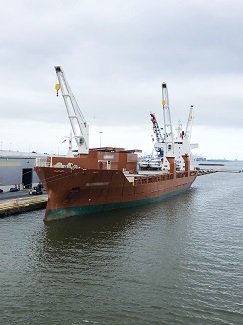Commercial Vessel Discharge Standards
 On December 4, 2018, the President signed into law the "Vessel Incidental Discharge Act" (VIDA) (PDF) (Title IX of the Frank LoBiondo Coast Guard Authorization Act of 2018). The VIDA restructures how EPA and the U.S. Coast Guard (USCG) regulate incidental discharges, primarily from commercial vessels, into waters of the United States and the contiguous zone. Specifically, the VIDA requires EPA to develop new national standards of performance for commercial vessel discharges and the USCG to develop corresponding implementing regulations. View more information on the VIDA.
On December 4, 2018, the President signed into law the "Vessel Incidental Discharge Act" (VIDA) (PDF) (Title IX of the Frank LoBiondo Coast Guard Authorization Act of 2018). The VIDA restructures how EPA and the U.S. Coast Guard (USCG) regulate incidental discharges, primarily from commercial vessels, into waters of the United States and the contiguous zone. Specifically, the VIDA requires EPA to develop new national standards of performance for commercial vessel discharges and the USCG to develop corresponding implementing regulations. View more information on the VIDA.
- EPA Proposed National Standards of Performance
- Interim Requirements
- Stakeholder Engagement Opportunities
- Frequently Asked Questions
EPA Proposed National Standards of Performance
On October 26, 2020, EPA's Notice of Proposed Rulemaking - Vessel Incidental Discharge National Standards of Performance - published in the Federal Register for public comment. Comments on the proposed rule must be received by November 25, 2020. Procedures for submitting comments are provided in the "Public Participation" section of the proposed rule.
EPA has made the decision not to extend the 30-day public comment period for the Vessel Incidental Discharge National Standards of Performance Proposed Rulemaking published in the Federal Register on October 26, 2020. This decision is based on several factors. Notably, EPA is currently working as expeditiously as possible to meet Congress’ two-year statutory deadline for EPA to finalize the rule. Additionally, the Agency posted the signed, pre-publication version of the proposed rule on its website and notified stakeholders of the availability of this version on October 6, 2020, essentially providing a total of 50 days for review before the close of the comment period on November 25, 2020.
The proposed rule would establish national standards of performance for incidental discharges from primarily commercial vessels under the VIDA. The proposed rule details specific discharge standards that would apply to 20 different types of vessel equipment and systems, as well as general discharge standards that would apply more broadly to all types of vessel incidental discharges.
As required in the VIDA, the proposed discharge standards are technology-based and in the form of numeric effluent limits and best management practices; distinguish among classes, types, and sizes of vessels, and between new and existing vessels; and are at least as stringent as the 2013 Vessel General Permit (VGP), with limited exceptions.
The proposed regulations also incorporate procedures for states, working through the EPA or the USCG, as provided for in the VIDA, to seek different discharge requirements, including no-discharge zones for one or more incidental discharges.
Visit our Stakeholder Engagement Opportunities page for an introductory presentation on the VIDA and the proposed rule, as well as information on three virtual public meetings scheduled for November 2020.
Interim Requirements
The following interim requirements continue to apply until EPA publishes final standards and the USCG publishes corresponding implementing regulations (anticipated in 2022):
- For large commercial vessels (≥ 79 feet in length), except fishing vessels: The existing vessel discharge requirements established through the EPA 2013 Vessel General Permit (VGP) and the USCG ballast water regulations, and any applicable state and local government requirements.
- For small vessels (<79 feet in length) and fishing vessels of any size: The existing discharge requirements for ballast water only established through the EPA 2013 VGP and the USCG ballast water regulations, and any applicable state and local government requirements.
View more information on the interim requirements:
